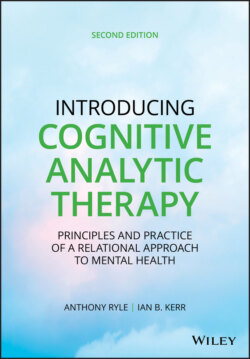Читать книгу Introducing Cognitive Analytic Therapy - Anthony Ryle - Страница 29
The Theoretical Model
ОглавлениеThe theoretical basis of practice was initially formalized in the Procedural Sequence Model (PSM), and this remains an important aspect of CAT. This offered a general model of how events are responded to, how intentional aims are pursued, and of how revision might or might not occur. The procedure or procedural sequence became the basic unit of description, providing the understandings needed to elucidate repetitive circular patterns of activity, including those problematic ones (dilemmas, traps, and snags) which were not revised. The sequence traces out and describes the following stages:
1 External factors: events, cues, and context.
2 Mental processes: (a) appraising the situation and the possibilities for action; (b) relating these to (possibly conflicting) existing beliefs, values, and aims; and (c) the selection of a response or action plan or role on the basis of predictions of its efficacy and outcome.
3 Action, including playing a role in a relationship.
4 Mental processes: (a) evaluating the consequences of the role or action; (b) confirming or revising the aim and/or the means used.
This model (described in Ryle, 1982) was compatible with current cognitive models but offered a more comprehensive and apparently more helpful description of the ways in which problem procedures remained unrevised. Affect, cognition, meaning, and action were seen to be intimately linked and were not studied in isolation from each other and the individual was understood in relation to past and present relationships with others. Many psychoanalytic concepts, including the relation of development to structure, could be restated in these terms. But it differed from both cognitive and psychoanalytic theories in its emphasis on the way in which the individual's interactions with others constantly reflect and largely maintain their self processes.
This basic theory needed further development in order to explain the formation of the self in early life and to clarify the problems in self‐management and relationships which are a principal concern of psychotherapy. This initially involved bringing ideas derived from object relations theories into the model. All procedures involve, frequently unconsciously, predicting, or seeking to achieve, certain outcomes. In seeking relationships with another, one plays a role based on the expectation of, wish for, or the attempt to elicit, one particular outcome, namely their acknowledgment and reciprocation (see Ryle, 1985). These procedures were therefore named “reciprocal role procedures” (RRPs) and were ultimately understood to emerge from early reciprocal roles (RRs) experienced with caregivers, siblings, and peers. These RRPs are seen, non‐judgmentally, as representing a person's “best efforts” at coping with frequently challenging or traumatic interpersonal experience. These concepts became of key importance in the revised model—the Procedural Sequence Object Relations Model (PSORM), and this remains the foundation of the CAT model. It should be emphasized that “role procedure,” as used here, implies action linked to memory, meaning, affect, and expectation. The common lay meaning of the subjective experience of playing a role can be understood as a state of mind or state of being. In contrast, the terms RRs and RRPs (see definitions below) describe somewhat more complex theoretical constructs.
